How AR Education Influences Learning Flow and Trainings: Revealed!
Updated 06 Jul 2023
15 Min
5619 Views
Augmented reality is strengthening its positions in our life each year. App stores add more and more entertaining AR apps, while large companies and startups come up with new ideas on how to implement AR in business processes. Education is one of the fields where AR can disrupt the industry. According to Statista, the global educational AR market share is $300 million as of 2020, but it’s expected to grow up to $700 million by 2025.
But how can augmented reality be used in education? In this post, we’ve singled out the benefits of AR in education, provided the best use cases of AR education, and shared pieces of advice on the AR software development process.
Augmented Reality in Education and Training
Education may seem quite an unusual industry for AR from first glance. The majority of users are used to entertainment AR apps. However, AR in learning can be a valuable part of tutorials and educational courses. It improves the way people learn and helps both students and tutors.
Conventional education establishments and professional training courses can implement AR in the learning process. Augmented reality in schools replaces paper textbooks. With its help, students don’t have to carry learning materials to classes because they have everything they need inside their smartphones. Moreover, schools can cut the expenses on learning materials and additional equipment like whiteboards, banners, and so on. Students will communicate with the teacher and access educational gear right in the app.
Learn how to compliment your AR learning technology with an educational mobile app development.
AR has obvious advantages for professional training courses too. Specialists from various fields can’t get required expertise without hands-on experience. For example, novice engineers won’t be allowed to fix a complex engine without knowing its structure. However, the only way for them to know the structure is to learn it from the textbook. Here’s the point where AR in learning comes to the rescue. With augmented reality education programs, engineers can examine a 3D model of a mechanism and disassemble it into small pieces.
Benefits of AR in Education
AR in education is easy-to-use and provides a variety of functionalities at the same time. This combination grants a number of benefits for users. So, let’s single out each benefit of augmented reality in education.
Immersiveness
Three-dimensional objects rewrite the traditional concept of education. Images of objects in books provide students with an understanding of the subject. Still, these images are 2D and can be seen from a single perspective. With AR apps, students can see the object from all sides and disassemble it. This is highly important for manufacturers of complicated mechanisms. Besides, 3D objects can be used for med students during anatomy classes.
Visualization
Augmented reality is linked to the visual perception of information. Scientists claim that we perceive more than 70% of information with our eyes. It means that AR learning helps to absorb information better. But there’s a need in high-resolution learning materials to achieve a quality result. Low polygonal models will hurt students’ eyes and worsen the educational process.
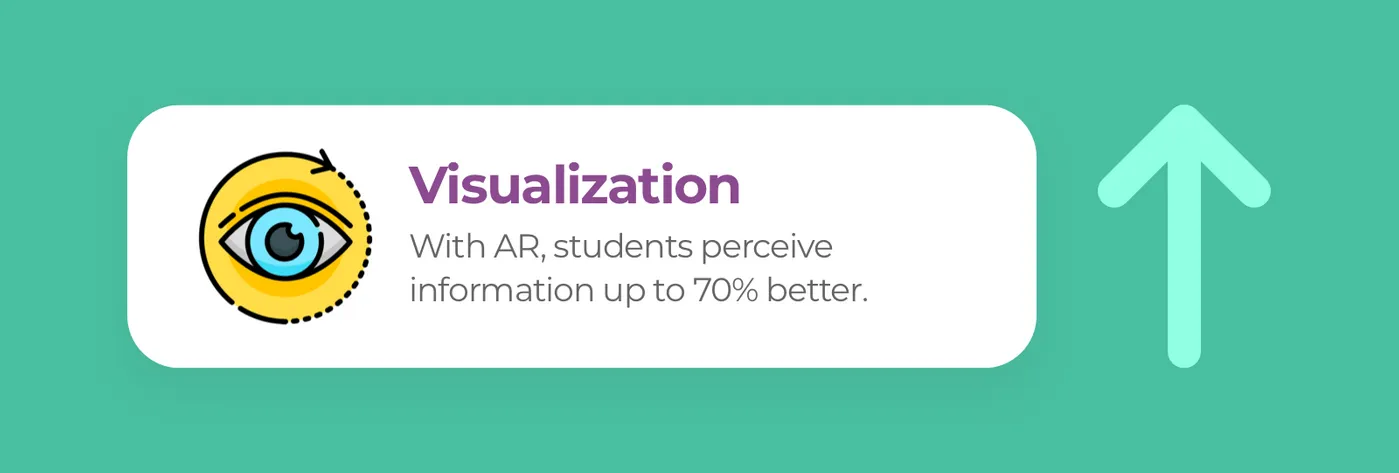
AR and perception of information
Engagement
Innovative learning approaches always grab students’ attention. The majority of children and adults would like to study with the help of advanced technologies like AR glasses and applications, rather than with old-fashioned textbooks and syllabuses. The increase in the engagement level leads to better students’ productivity and overall performance. Consequently, students’ results affect the reputation of educational establishments.
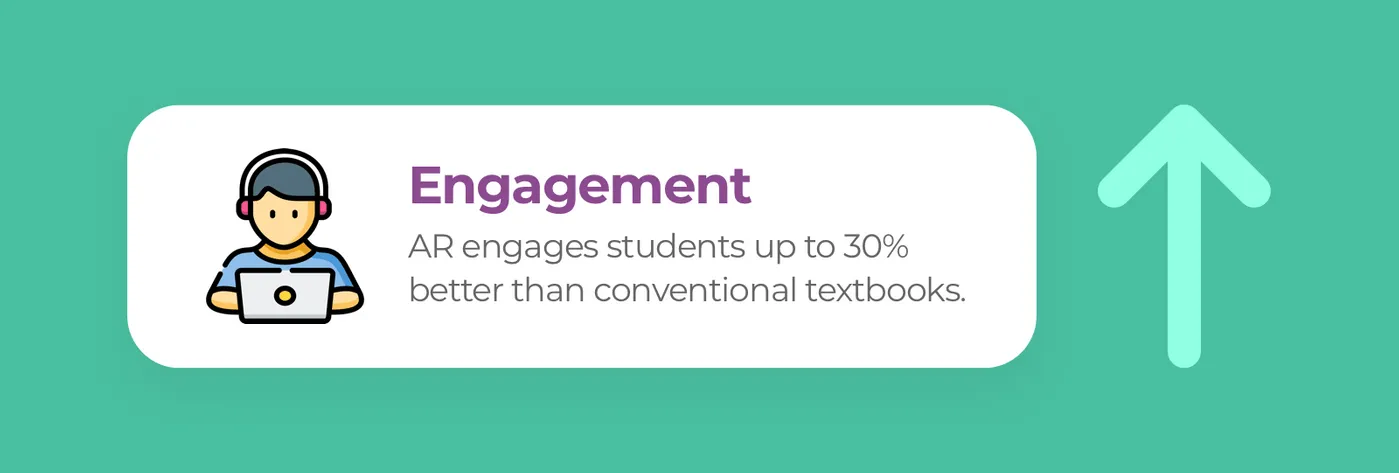
Engagement rate
Safe training
A novice surgeon can’t perform heart surgery on the first try. Just like the pilot can’t take the plane off the ground without proper training. However, specialists from these fields can’t practice in real situations. AR in learning and mixed reality applications help them to get the required experience. For example, Microsoft Flight Simulator reproduces a range of real-life planes and allows pilots to train their skills in VR or mixed reality headsets. Plane physics is close to reality, so pilots will better understand the real plane during their first flight.
Collaboration
Instead of examining the same picture in textbooks, students can use collaborative AR applications and work on the same object together. They can modify objects and leave comments, so the teacher can answer them later. This collaborative approach engages teamwork and improves student-teacher connection.
Challenges of AR in Education
Even though AR learning has a wide range of advantages, it also has a price to pay. The transition to a digital workflow is always tricky and this section will help you to avoid common pitfalls.
Let’s single out the major drawbacks of augmented reality technology in education.
The cost of devices
Unfortunately, expensive devices are a must to get the most of AR learning. The majority of up-to-date mobile phones support the AR technology, so it’s not a problem to find a device that can run the app. However, budget phones lack the resources to run the app for several hours straight. The performance gets worse over time, while the battery runs low. For example, older iPhone models like 6S and 6S Plus can launch the app, but the battery capacity isn’t enough to use it for two classes in a row.
There are several solutions to this problem. The first one is expensive. Educational establishments can provide students with powerful AR tools for education during the educational process. This option grants smooth performance for every student but costs a lot. A mid-tier mobile device or tablet costs about $500 - $600, so the set of phones for a group of ten students will cost $5,000 - $6,000.
Or else, students’ can be obliged to bring portable charging devices to the class. This option doesn’t solve the performance issue, but at least students will be able to work with the app at the class. Besides, entrepreneurs don’t have to waste money on additional equipment.
If you’re into professional training, your expenses will rise even more. Different simulators require VR or mixed reality headsets and compatible hardware to launch the AR learning app. The price for a set of devices for a single person may reach $2,000. Besides, it may be inconvenient to work while holding a mobile phone, so you’ll have to provide students with a set of AR glasses like Google Glass, that cost around $1,000. Consider these expenses while building a business plan.
Stable connection
To deliver all learning materials (3D models, lecture materials, and so on), you’ll have to use the cloud. Students can download materials before the classes or right in the middle of the session. In both cases, the app should have a stable connection with the cloud. Any disruptions in downloading and accessing the cloud may result in disruption of the educational process. Such issues will lower your reputation, so make sure that you’re using a reliable cloud services provider.
We can recommend Amazon Web Services and its cloud storage. With Amazon Simple Storage Service (S3), you can get a gigabyte of space for $0,022 per month. Mind that the price depends on your region and the amount of space you need. AWS grants the data integrity and 24-hour access to the cloud storage, so you don’t have to bother with availability issues.
What’s the Use of Augmented Reality in Education?
It’s hard to deny the advantages of AR in education, but to make the most of it you have to understand how to use augmented reality in education properly. Now, we’ll go through the best use cases of educational AR solutions that prove its effectiveness.
Use Cases of AR in Schools
Private and public schools can boost teachers' and students' productivity, engage students in the learning process, and improve teamwork.
Here are the most prominent augmented reality examples in education:
Complete Anatomy
Complete anatomy is a cross-platform app for med students and professional physicians. This app provides users with more than 17,000 human body structures available as 3D models. Students can interact with each of them both conventionally and by projecting body parts on a flat surface.
Augmented reality lets users get a better understanding of body anatomy. With the help of a virtual body, students can learn functions of every muscle, watch detailed muscle movement animations, dismantle large bone structures to smaller ones, and study different bone layers. Besides, the app can host multi-user sessions, so students and doctors can work together on the same project.
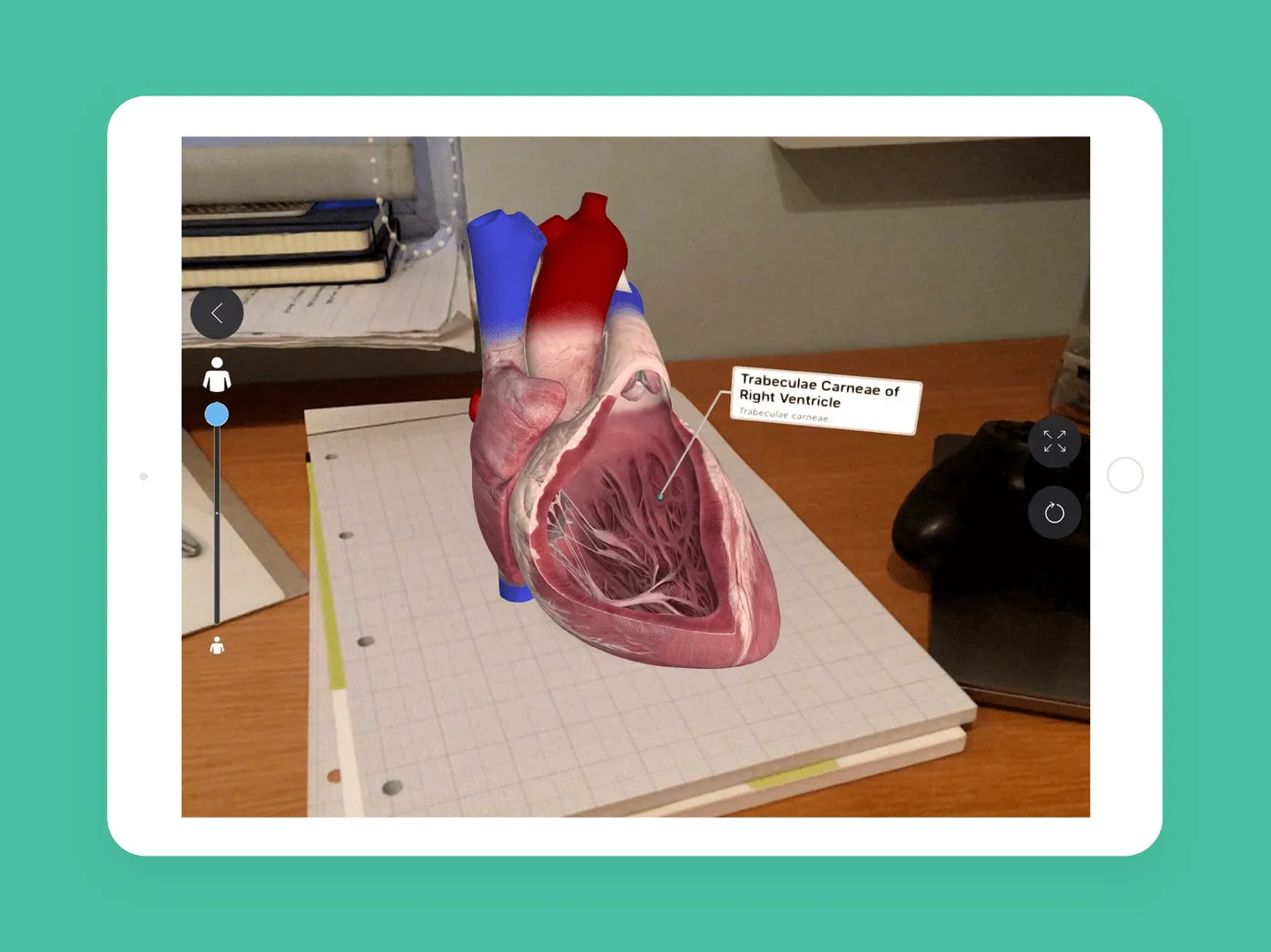
Complete Anatomy app
Star Chart
Star Chart is another example of augmented reality in education for astronomy enthusiasts. When users point their devices at the sky, the app highlights the constellation on the screen and provides users with its comprehensive description. It also shows information about separate stars. The app has a database of more than 120,000 stars and 88 constellations, so there’s quite a lot of content for astronomers.
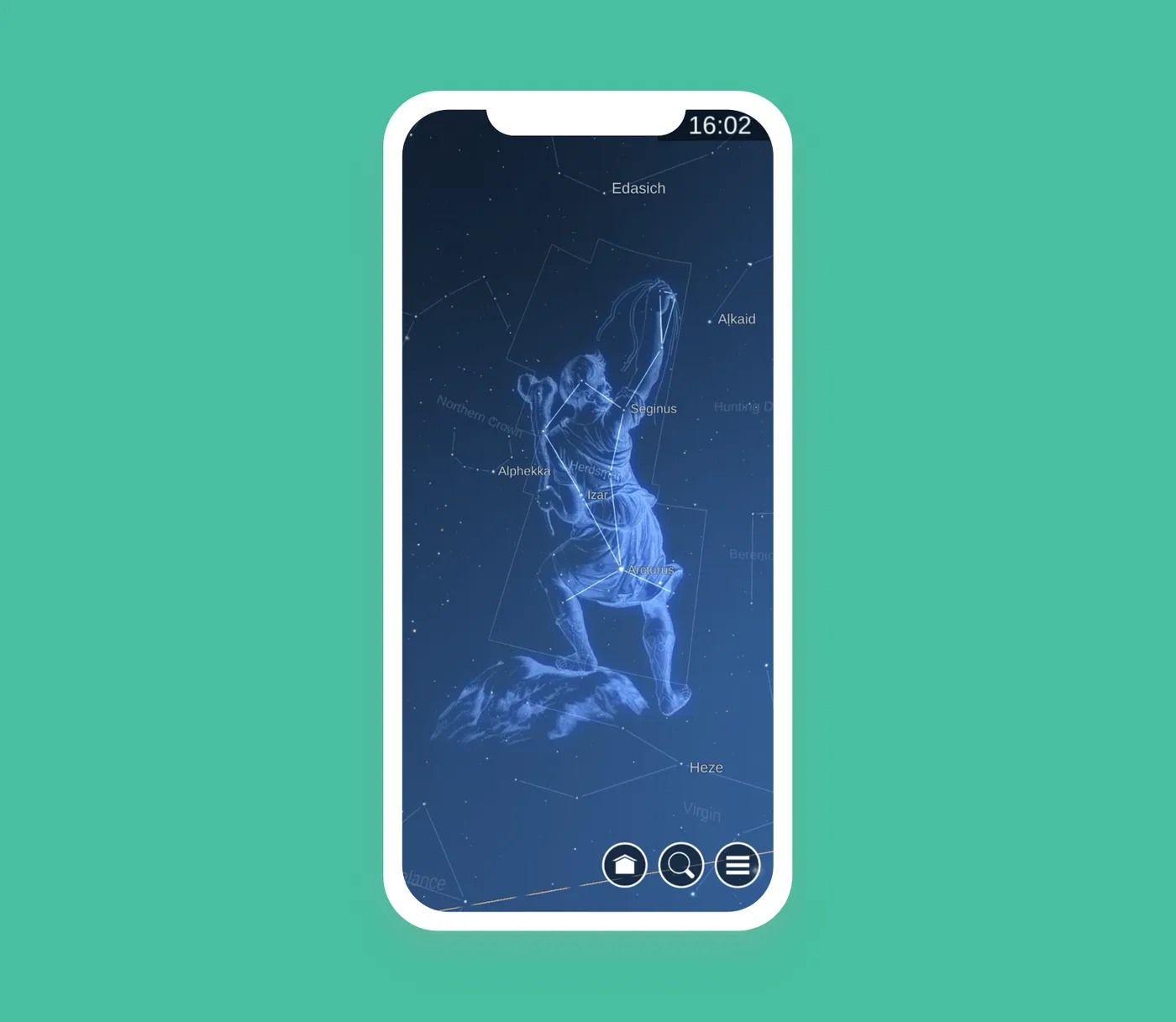
Star Chart app
JigSpace
JigSpace is an app for AR presentations. It can be a useful AR tool for education and business fields. With JigSpace, you can create a project demo at no time. The software allows users to upload 3D models into the app, place them on slides, adjust them as they need, and present it to the audience.
Companies use JigSpace for rapid prototyping and presenting products to investors. Meanwhile, educational establishments use JigSpace for illustrative classes and visualization of materials.
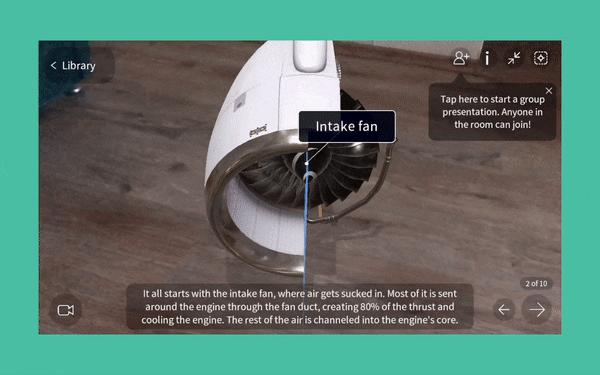
JigSpace app
Use Cases of AR in Training
Apart from public schools, various companies and organizations can use AR for professional training, internships, and more. Let’s find out how businesses use AR learning for the benefit of their employees.
Japan Airlines
Microsoft cooperated with Japan Airlines on an augmented reality learning project. With the help of Microsoft Hololens, the flight crew can train in close-to-real conditions. Previously, trainee pilots had to watch tons of educating videos before getting into the cockpit and actually interacting with the plane. Now, the crew can study engine mechanics and plane navigation with the help of Microsoft Hololens.
By the way, Japan Airlines already had an experience with augmented reality. They’ve used Google Glass to perform plane inspections and control the luggage with the help of QR codes.
Siemens
Siemens uses an AR leaning app to train their employees in welding. Siemens believes that trainees often face complicated and dangerous tasks, so they need to train staff in safe conditions. With the help of special barcodes, the software simulates the welding process and projects results to the AR device and mentor’s screen. After the training, the software shows the exercise’s precision, so that the trainee can know their weak sides from the mentor.
This solution lets students and workers to train more frequently and track results better. Besides, it saves resources, so you can cut practice expenses in the future.
Jaguar Land Rover
Jaguar Land Rover (JLR) cooperated with Re’Flekt to reduce the cost of employee training on the real objects. Employees training with real cars is very efficient, but it’s too expensive. That’s why JLR searched for a solution that could provide employees with an understanding of the car’s internal structure without removing and reinstalling its parts.
With the help of Re’Flekt One, JLR created an augmented reality tool for education that shows everything that is hidden behind the panels. Now, engineers can point the camera at any place and observe the mechanical and electrical parts of the car. Moreover, the app shows 3D models of every component, connections, and wiring diagrams. With these features, instructors perform training on the vehicle without the costly reassembly time.
How to Implement AR in Education
If you’ve come up with the idea for an AR learning app you have to understand the process of converting that idea into a functioning product. You can face several obstacles during augmented reality learning app development that should be considered beforehand. In this section, we’ll discuss all steps you need to take to implement AR in education.
Defining Target Audience
First off, you should define your target audience. If your product appears worthless to educational establishments and training organizations after the development, all the efforts will be wasted in vain. So, before approving the feature list, conduct user research.
You have to clearly understand who your customers are and what their demands are. If you’re aiming at a professional training niche, contact a certain company you want to cooperate with. Your solution can’t be an all-purpose tool for every company, so it’s better to find a single partner, understand their demands, and create a product that satisfies their needs.
On the other hand, if you’re aiming at AR for schools and other educational establishments, your product can be more general. Transferring textbooks into an AR environment, developing 3D models for various classes, and enhancing cooperation between students are the fundamental goals for augmented reality in schools and universities. However, you have to study your competitors’ software and offer unique features. If your app just copies all the features of another app, most likely no one will use your solution. So, make sure that your app offers better performance, quality 3D models, and some exceptional features.
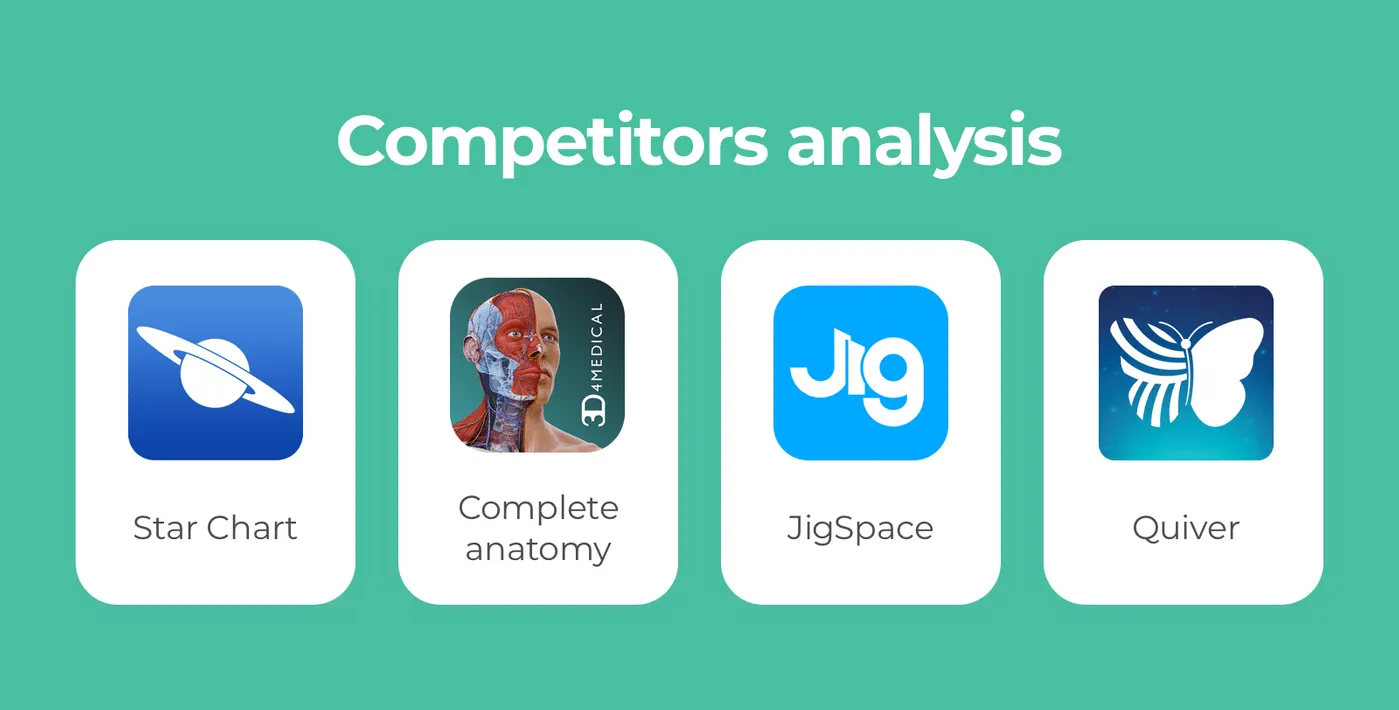
Well-known AR apps in education
Idea Validation
To understand the relevance of your idea, you have to gather preliminary feedback. Draw up a business plan, create a working prototype of your product, and contact investors. If you’re a startup, you have to comply with all the investors’ requirements. Still, investors’ perspectives may differ from yours. Stakeholders may want to rebuild the majority features or even change the whole concept of the AR learning app.
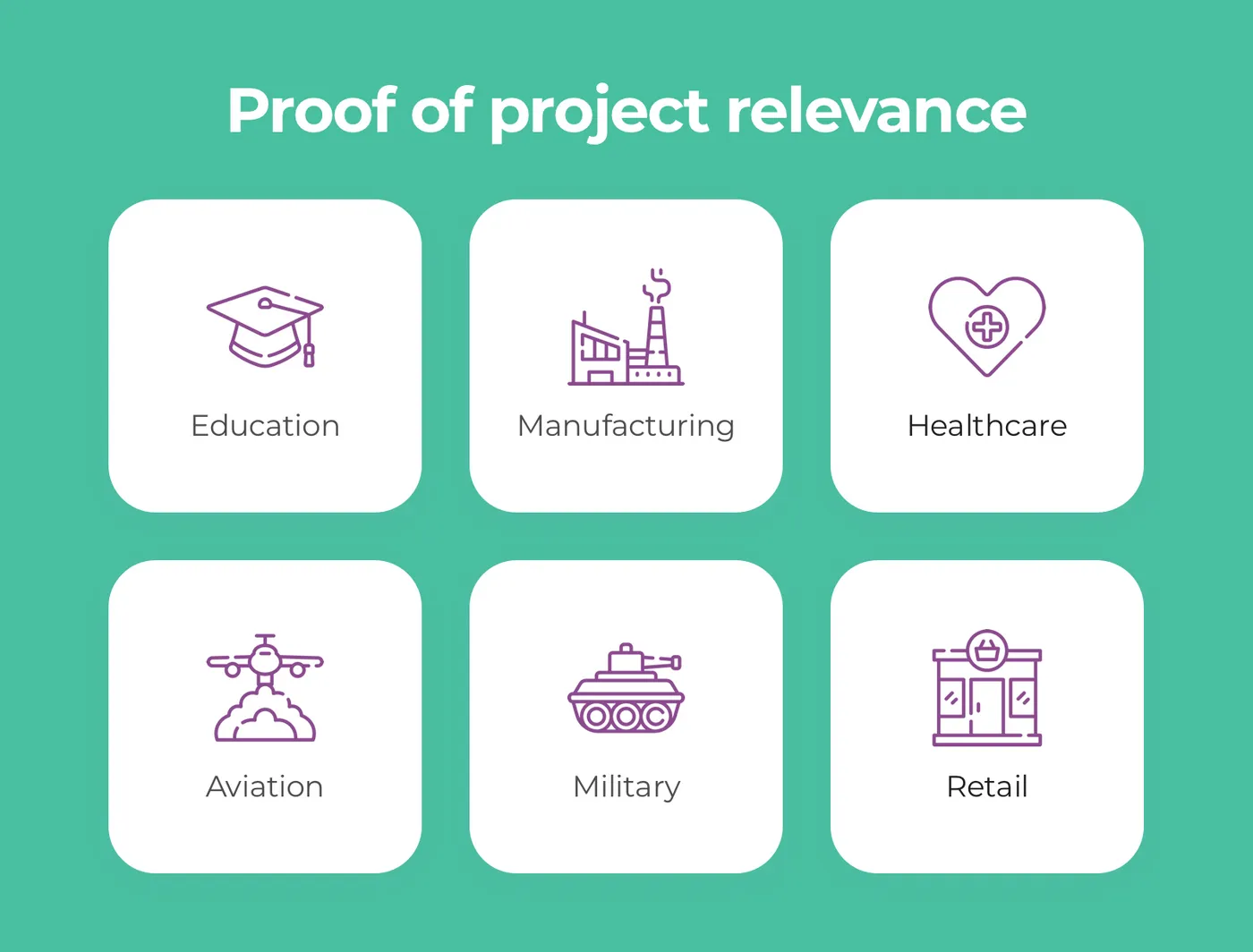
Industries where AR can be used successfully
If that’s your case, it’s better to find new investors or come up with a new solution by dialogue. If you comply with all demands, the project will lose the initial value and uniqueness. Plus, redesigning all features may be time-consuming and not worth the efforts. However, if you want to avoid such situations in the future, you have to contact a professional software development company. They usually know all software development trends concerning augmented reality in education, so they can help you save the charisma of your app and achieve stakeholders’ endorsement.
Looking for a tech partner?
Our business analysts can help you with a feature list and estimate the project cost for free!
MVP Creation
Minimum Viable Product (MVP) is an approach that helps digital products to collect data about actual users and pitch investors with a working product. MVP is the first version of the product with basic features. Entrepreneurs usually use MVP to conduct usability testing and gather initial feedback from clients.
Learn how to build MVP and present your product to users
With this information, you can understand whether your idea works as planned, or you need to make some changes in the software. Also, if the app turns out to be unpopular among the audience, you can suspend the project with minimal losses. MVP takes less time than the development of a full-fledged product, so you’ll minimize your expenses.
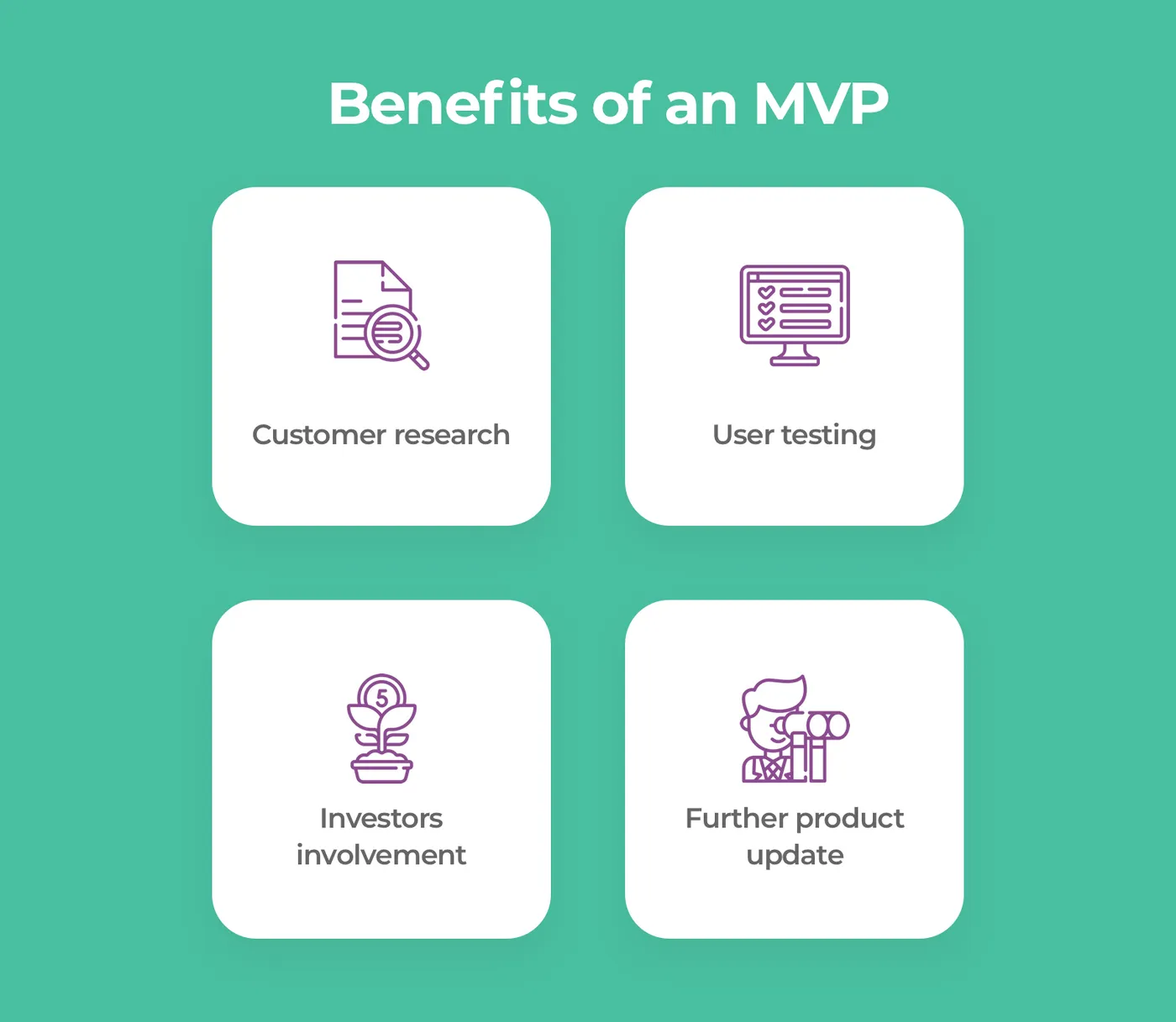
4 main benefits of an MVP
Tech Stack
To use AR technology in education, engineers use two main AR software development libraries. ARCore and ARKit are two rivals in the world of augmented reality. Let’s discover each of them in detail.
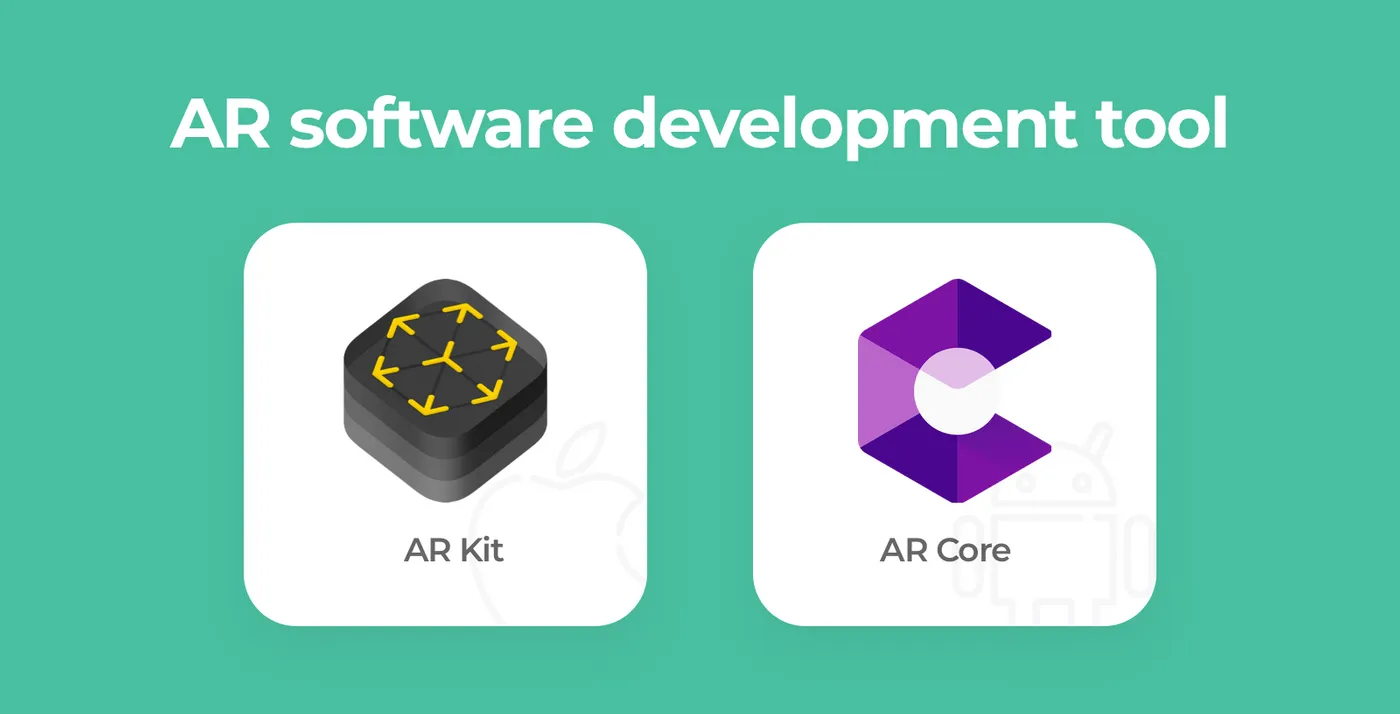
Best tools for AR in education
ARCore
ARCore is Google’s platform for building Android-based augmented reality applications. ARCore uses three basic principles to integrate virtual content into the real world: Motion tracking. A smartphone understands its position. Environmental understanding. The smartphone is able to detect the size and location of surrounding surfaces. Light estimation. The phone can estimate the light level.
ARCore's motion tracking technology uses the phone's camera to find interesting points and tracks the movement of those points. ARCore determines both the position and orientation of the phone as it moves through space.
It detects flat surfaces like a table or the floor, and can also estimate the environmental lighting. These capabilities help ARCore to build its own understanding of the world around it which grants an uncut experience of augmented reality in education and training.
On top of that, a new technology called ARCore Depth helps to understand the depth and precise position of surroundings. The phone will track the smallest details on the scene. This technology opens new opportunities for AR learning and entertainment.
ARKit
ARKit is the same thing as ARCore except that it’s used for iOS app development. Rivals keep pace with each other and introduce innovations at the same time. That’s why the latest ARKit 4 supports Depth API with the help of Apple TrueDepth Camera.
Among the reported differences, the only significant one is that ARCore performs scene mapping faster than ARKit. Still, the speed harmed the mapping precision, that’s why ARKit is more accurate at detecting the scene.
Of course, these aren’t the only technologies that developers use during AR learning app development. Here’s an approximate list of technologies that you’ll need to integrate augmented reality in education:
- Programming languages: Swift, Kotlin, Java
- Hosting: Amazon EC2
- API server: Node.js
- AR Tools: ARCore, ARKit
- Database: MySQL, Oracle
- Push notifications: Firebase Notifications
- Cloud storage: Amazon S3
How Can Cleveroad Help You?
At Cleveroad, we know how to create immersive augmented realities. Our engineers worked on augmented reality education software for several education establishments. That’s why we understand the importance of smooth performance and intuitive interface for students. Besides, some of our engineers are keen on AR development and always try to contribute to the open-source AR community. One of our latest projects was an open-source color changing-library. You can get more details in our case study.
Got an AR app idea?
Our engineers will be glad to help you with a tech stack and the overall app concept for free!
Augmented reality in schools replaces paper textbooks. With its help, students don’t have to carry learning materials to classes because they have everything they need inside their smartphones. Moreover, schools can cut the expenses on learning materials and additional equipment like whiteboards, banners, and so on. Students will communicate with the teacher and access educational gear right in the app.
AR can engage students in education better. It removes conventional textbooks and provides students with visual information.
AR has obvious advantages for professional training courses too. Specialists from various fields can’t get required expertise without hands-on experience. For example, novice engineers won’t be allowed to fix a complex engine without knowing its structure. However, the only way for them to know the structure is to learn it from the textbook. Here’s the point where AR in learning comes to the rescue. With augmented reality education programs, engineers can examine a 3D model of a mechanism and disassemble it into small pieces.
One of the best example of AR in higher education is Complete Anatomy. This app provides users with more than 17,000 human body structures available as 3D models. Students can interact with each of them both conventionally and by projecting body parts on a flat surface.
Augmented reality lets users get a better understanding of body anatomy. With the help of a virtual body, students can learn functions of every muscle, watch detailed muscle movement animations, dismantle large bone structures to smaller ones, and study different bone layers. Besides, the app can host multi-user sessions, so students and doctors can work together on the same project.
- Immersiveness
- Visualization
- Engagement
- Safe training
- Collaboration
Augmented reality helps student to understand the learning material better and experience less education-related issues. Moreover, AR in professional trainings grants safety for students.
With time, Augmented Reality will be used in trainings more often. For now, Siemens already implements AR to train their employees in welding, while Jaguar Land Rover uses AR to explain their employees how the cars are assembled.

Evgeniy Altynpara is a CTO and member of the Forbes Councils’ community of tech professionals. He is an expert in software development and technological entrepreneurship and has 10+years of experience in digital transformation consulting in Healthcare, FinTech, Supply Chain and Logistics
Give us your impressions about this article
Give us your impressions about this article
Comments
4 commentsThanks for sharing valuable info
AR in education is the future of all students. When devices like Google Glass will be more affordable it'll be a revolution in the industry. By the way, thanks for your work!
Great post!
As a medical student I've use Complete Anatomy and can confirm the benefits that this app brings to students. Visualization really helps to memorize more information, so learning gets better.